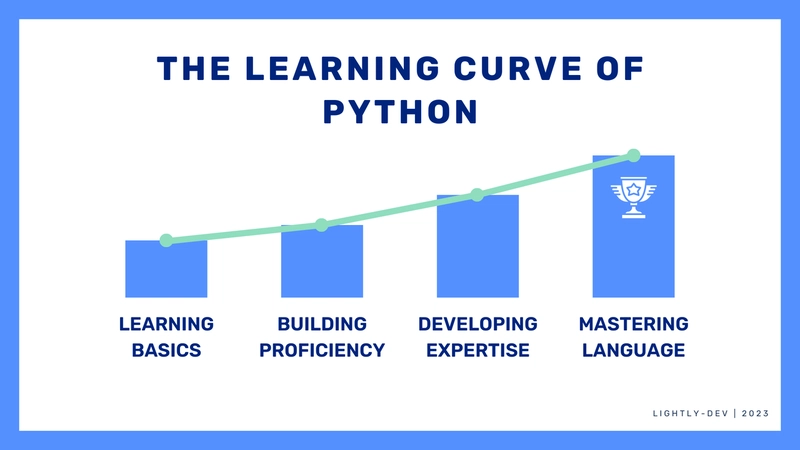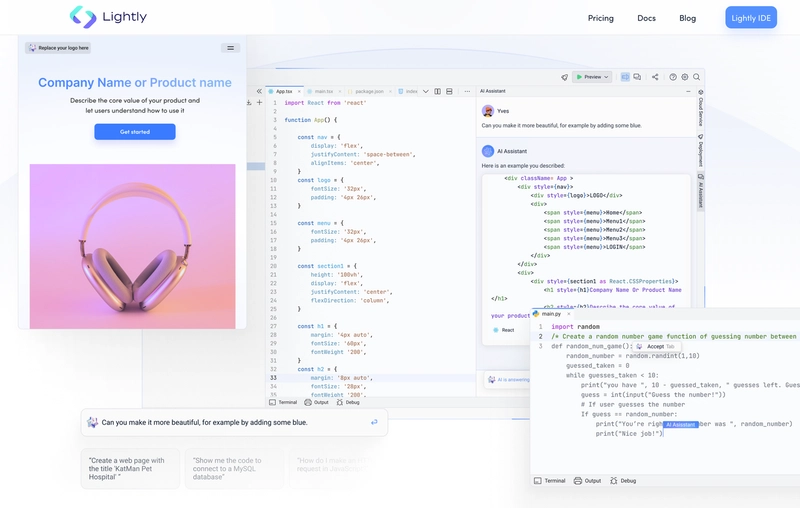Python has become one of the most popular programming languages in recent years, and its popularity continues to grow.
In the tech industry, Python is commonly used in web development, data analysis, machine learning, and artificial intelligence. It is also widely used in finance, healthcare, and education, among other industries.
Python's popularity can be attributed to its ease of use, readability, and extensive libraries and frameworks, making it a preferred language for many developers and organizations. As a result, learning Python has become an essential skill for many aspiring developers and professionals in various fields.
Why Python is Challenging
Python is known for its simple and elegant syntax, but some aspects of it can be challenging for beginners.
One of the unique features of Python is its use of whitespace to delimit blocks of code, instead of using curly braces or other delimiters like other programming languages. This can be confusing for those used to more traditional syntax.
Additionally, colons are used to indicate the beginning of a new block, adding another layer of complexity to the language's structure. However, once understood, these features can make Python code more readable and easier to follow.
It's important for new learners to spend time mastering these concepts to become proficient in writing Python code.
Indentation in Python
Unlike other languages that rely on braces or keywords like "begin" and "end" to indicate where a block of code begins and ends, Python uses whitespace. This means that consistent indentation is not only good practice, but it's also required for code to run correctly.
While this can be a bit challenging for beginners who are used to other languages, it's also one of the reasons why Python code is often more readable and easier to maintain.
Use of Colons in Python
Colons are an important aspect of the Python language. They are primarily used to introduce a new block of code, such as in a for loop or an if statement. Additionally, colons are used to indicate a function or method definition.
In Python, colons are also used in list slicing to indicate a range of values. They can also be used in dictionary comprehension to separate the key from the value. In general, colons are an essential component of Python syntax and mastering their use is key to becoming proficient in the language.
Understanding data types in Python and How They Work
Unlike languages like Java or C++, Python does not require you to declare the type of a variable before using it. Instead, Python automatically assigns the data type based on the value assigned to it. While dynamic typing makes Python code shorter and more flexible, it also requires you to have a thorough understanding of data types and how they work.
You need to be aware of potential type mismatches and the impact they can have on your code's behavior. However, once you grasp the basics, Python provides an intuitive and accessible way to work with data.
Python has various built-in data types, including strings, integers, floats, and booleans, each having its unique characteristics and uses. Understanding these data types and how to manipulate them is essential for writing efficient and effective Python programs.
Python is a dynamically typed language, meaning that the data type of a variable can change during runtime, which can be both a benefit and a challenge for beginners. However, by taking the time to understand data types thoroughly, beginners can write better code and avoid common errors.
Large standard library in Python and how to use it
Python is known for its extensive standard library, which includes modules for everything from accessing databases to working with regular expressions. However, the vast amount of available functionality can be overwhelming for beginners.
It takes time to learn what modules are available and how to use them effectively. The good news is that Python's documentation is excellent, and there are many online resources available to help you learn. Once you become familiar with the standard library, you'll have a powerful set of tools at your disposal for building complex and sophisticated applications.
The Python standard library is a collection of modules and packages that come pre-installed with the Python interpreter. It provides a wide range of functionality, making it easier to accomplish common programming tasks without the need for external dependencies. Here are some key modules included in the Python standard library:
- os module: Provides functions for interacting with the operating system, such as file and directory operations.
- math module: Offers mathematical functions and constants for numeric computations.
- datetime module: Enables manipulation and formatting of dates and times.
- json module: Provides functions for working with JSON data, including serialization and deserialization.
- random module: Allows generation of random numbers, making it useful for simulations and games.
- urllib module: Enables handling of URLs and performing various operations like fetching web pages and making HTTP requests.
- csv module: Facilitates reading and writing of CSV (Comma-Separated Values) files.
To use these modules, you simply need to import them at the beginning of your Python script. For example:
import os
import math
import datetime
import json
import random
import urllib
import csv
Once imported, you can access the functions, classes, and constants provided by these modules by using their respective names and following the documentation and examples provided for each module. For instance, you can use os.listdir() to list files in a directory, math.sqrt() to calculate the square root of a number, or datetime.datetime.now() to get the current date and time.
Difficulty in debugging code in Python
Debugging code is one of the most challenging tasks in programming. It can be time-consuming and difficult, especially for beginners. Python is no exception to this rule.
While Python is known for its simplicity and readability, it can also be a bit tricky to debug. One of the reasons for this is that Python is an interpreted language, which means that errors are only detected when the interpreter reads the code. This can make it hard to find the source of the error, particularly if it is a logic error.
However, the good news is that Python comes with its own debugger, which can help you identify and fix errors in your code. With some practice, you can become an expert at debugging Python code.
For example, the online Python compiler in Lightly comes with a built-in debugger. You can click the debug button on the top right or right-click on the editor to select "Debug Current File" and start debugging. Read the debugging documentation for more detailed step-by-step guide on debugging.
Why Python is Accessible to Learn
Python has become one of the most popular programming languages due to its beginner-friendly and easy-to-read syntax. It uses indentation to delimit blocks of code which makes it easy for beginners to understand. Python also has a minimal setup requirement, making it easy to install and start using immediately.
Additionally, Python has an interactive shell which allows users to test and experiment with code snippets without the need for a separate development environment. With these features, Python is an accessible language for beginners to learn and experiment with.
Easy-to-read syntax
The language uses plain English words and has a simple structure that is easy to understand. Python code is organized using white spaces, eliminating the need for excessive brackets or semicolons that are common in other languages like C++ or Java.
This simplicity makes Python code easier to read and understand, even for those who are new to programming. Additionally, Python's syntax is highly consistent, meaning that once you learn the basic structure, you'll be able to easily apply it to different parts of the language.
Minimal setup required
Python is an interpreted language, which means that you don't need to compile your code before you can run it. All you need to get started is a Python interpreter, which is freely available for download from the official Python website.
The interpreter comes with a basic set of libraries, but there are also many third-party libraries available that can be installed with just a few simple commands. Additionally, Python is cross-platform, which means that you can write and run your code on any operating system, including Windows, Mac OS, and Linux, without having to make any modifications.
In Lightly IDE, it makes coding Python even simpler and easier by eliminating all the installation processes. You can code right in your browser or even on your iPad (by downloading it in the AppStore or accessing through Safari).
Vast amount of online resources and tutorials
The richness and diversity of these resources make Python an accessible language for beginners and experts alike. Online tutorials, forums, and documentation are widely available, allowing learners to access different learning styles, formats, and levels.
Python's popularity and its open-source nature mean that there are endless examples, libraries, and tools to explore and use. Whether you prefer structured courses or self-paced learning, Python has something for everyone. Additionally, Python's active community ensures that documentation and tutorials are continually updated and improved, making learning Python an enjoyable and rewarding experience.
We've got a series of Python tutorials for you to start off with. Feel free to read any of our tutorials on our blog. Tutorials for other programming languages like Java, PHP, C/C++ are also available.
- How to Execution Time in Python
- Mastering Python's If-Else Shorthand
- Calculating Entanglement Entropy with Python
Versatility of Python in Various Industries
Python is a popular language that can be used in a wide range of industries. It is widely used in data analysis and web development, as well as in machine learning and artificial intelligence. In the data analysis field, Python provides powerful libraries for data manipulation, statistical analysis, and data visualization.
In web development, Python frameworks such as Django and Flask are widely used for building web applications. With its versatility, Python continues to be a valuable language for various industries seeking to develop efficient and effective solutions.
Python is also well-known for its versatility and can be easily integrated with other programming languages. This makes it an ideal language for working on complex projects that require a combination of different languages. For example, Python can be used for web development with HTML, CSS, and JavaScript.
It can also be used for data analysis with R or MATLAB, or for scientific computing with C++. The ability to work with multiple programming languages makes Python a popular choice among developers and programmers alike.
Tips for Learning Python: Is Learning Python Hard?
We can't guarantee that learning Python is an easy task, but with all the resources available on the internet, learning Python might be easier than you thought.
The learning curve of Python (and any other programming languages) is steep. It can be rather easy to learn the basics just as we're learning the ABCs. However, to become a Python master, you will still need a lot of time and effort. It usually takes a few months to learn the basics of Python, but the whole learning process would take years or even a lifetime with the rapid changing technology world.
Don't worry about mastering the hard part, but just start with the basics. This means understanding variables, data types, and control structures. Variables are used to store values, while data types define the type of data that can be stored in a variable. Control structures are used to control the flow of a program.
Understanding these concepts will help you build a strong foundation in Python programming. Once you have a good grasp of the basics, you can move on to more advanced topics such as functions, modules, and object-oriented programming.
Practice, practice, practice
To truly understand and become proficient in Python, it's important to practice writing code and working on projects.
Reading books and tutorials can only get you so far. The more you code, the more you'll get used to Python's syntax and structure. Working on projects also allows you to apply what you've learned and see how all the pieces fit together. It's important to start with small projects and work your way up to more complex ones. Don't be afraid to make mistakes; they're a natural part of the learning process. As you practice more and more, you'll gain confidence in your abilities and become a more skilled Python programmer.
Write code and work on projects to solidify understanding
When starting out, it's best to begin with simple projects and gradually work your way up to more complex ones. This will help you build confidence and develop a deeper understanding of the language. Some good beginner projects include building a calculator, creating a simple game, or writing a script to automate a task.
As you progress, you can move on to more challenging projects, such as building a web application or working on a machine learning project. These types of projects will require a deeper understanding of the language and more advanced coding skills, but they will also be incredibly rewarding and help you develop your skills even further.
Utilize resources: Online tutorials, textbooks, and forums can all be helpful
When it comes to learning Python, there is no shortage of resources available online. Online tutorials can be a great way to get started with the basics of the language, and there are many free and paid options to choose from. Textbooks are another valuable resource for learning Python, as they offer a more comprehensive approach to the language and often include exercises and examples to help reinforce what you have learned.
Additionally, online forums can be a great way to connect with other learners and get help with any questions or problems you may encounter along the way. By utilizing these resources, you can make your journey learning Python much more accessible and enjoyable.
Another excellent way to learn any new skill is by seeking the help of others. When it comes to learning to code in Python, there is a vast community of learners and experts willing to share their knowledge with you. Whether it is through online forums, social media, or coding communities, there is no shortage of resources available to help you improve your skills.
Not only can you learn from others' experiences and mistakes, but you can also get feedback on your code, ask questions, and gain new insights into the language. So, don't hesitate to seek help and support from the Python community!
Lightly IDE as a Programming Learning Platform
Are you struggling with solving errors and debugging while coding? Don't worry, it's far easier than climbing Mount Everest to code. With Lightly IDE, you'll feel like a coding pro in no time. With Lightly IDE, you don't need to be a coding wizard to program smoothly.
One of its standout features is its AI integration, which makes it easy to use even if you're a technologically challenged unicorn. With just a few clicks, you can become a programming wizard in Lightly IDE. It's like magic, but with fewer wands and more code.
If you're looking to dip your toes into the world of programming or just want to pretend like you know what you're doing, Lightly IDE's online Python compiler is the perfect place to start. It's like a playground for programming geniuses in the making! Even if you're a total newbie, this platform will make you feel like a coding superstar in no time.












Top comments (0)